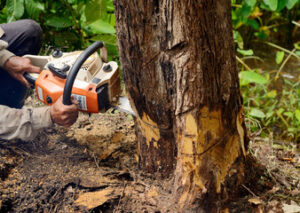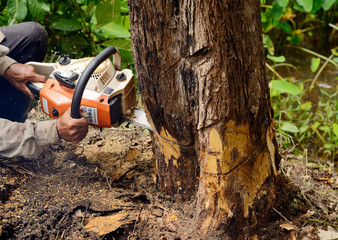Trees that are diseased or weakened can present serious safety risks to your family and property. They can fall on cars or power lines, potentially killing someone or causing significant damage.

Before you begin tree removal, be sure to clear the area around it and put on protective equipment, including gloves and eye protection. Then, you’ll need to decide which method of removal is best for the job. Contact Worcester Tree Removal for professional help.
Trees are an important part of the landscape, but sometimes they can become a nuisance. This is especially true if they are in the way of a driveway, house, or power lines. Luckily, there are many ways to deal with such problems. However, it is always best to consult a professional before taking matters into your own hands.
A good starting point is to look at the tree and see if it has any damage or unusual growths. This can help you determine if the problem is simply due to old age or if it’s something more serious. You should also check to see if the tree is diseased or if there are any signs of insect infestations. A qualified arborist will be able to identify these issues and advise you on the appropriate course of action.
If a tree is exhibiting any of these symptoms, it may be time to consider tree removal. Depending on the situation, this could be as simple as pruning or removing the entire tree. However, in severe cases, a professional should be called to ensure that the job is done correctly and safely.
Before beginning the process, make sure to clear the area surrounding the tree. This includes removing any children or pets from the area and making sure that everyone besides the person felling the tree is at least double the distance away. You should also wear proper protective equipment, including gloves and eye protection. It’s also a good idea to get a chainsaw that has a bar as long as the tree.
Lastly, be sure to check the ground around the stump for any roots that have grown into the soil. This can be tricky, but if you’re willing to put in the effort, it can be easily accomplished. Once the root system has been removed, you can use the space for other purposes, such as planting new trees or creating a garden.
Whether the problem is a dead or dying tree, a pest infestation, or just one that is in the wrong location, there are several reasons to consider hiring a professional for tree removal. It’s a dangerous job that should only be performed by a company with the necessary tools, insurance, and training to do it safely.
Taking Precautions
Trees are important parts of a yard or garden, but they can also pose hazards if they are not removed properly. They can fall on a person or structure and cause damage. When a tree is dying or is leaning over a house, car, or power line, it should be removed as quickly as possible. A professional can handle this task in a safe and effective manner. To do this, they will assess the condition of the tree and the surrounding area and take the necessary precautions to protect their workers and those in the vicinity.
Before cutting the tree, it is crucial to perform a thorough site assessment and clear the surrounding area. The area should be free of cars, tools, and other outdoor furniture. The site must also be analyzed for any potential obstacles, such as power lines. The professionals will make a notch cut on the side facing the direction that the tree will fall and a back cut to ensure that the entire tree falls in the proper place.
It is also a good idea to check the weather conditions, as stormy weather can increase the risk of accidents during the process. Lastly, it is essential to remove the branches and roots that are not attached to the trunk. This can prevent the spread of disease and improve air circulation around the yard or garden.
Another option is to trim the trees instead of removing them completely. This can prevent diseases, improve the health of the trees, and even increase the amount of sunlight that reaches the ground. In addition, it can help control the growth of the tree and reduce the risk of a collapsed roof or other structures.
Tree removal is a complex and dangerous process that should be done by experienced professionals. The experts from S&P Tree Service will assess the situation and determine the best course of action. The company will provide safety equipment and take the necessary steps to safeguard themselves and those in the area. They will also be sure to follow local regulations and laws.
Getting the Permit
You must get a permit before you remove any trees on your property. If you want to cut a tree with a caliper of six inches or more (diameter measured at four and a half feet high from the ground) on your property, you must first submit a permit application. Exceptions are made for emergencies, such as storm damage or disease. The Tree Commission will review the condition of the tree and determine if it should be removed.
The permit application must be completed in full, signed by the owner of the property, and contain all information required by borough code. If a property survey is available, it should be attached to the application. If not, a sketch of the property with the locations of all trees should be included. The application should also clearly identify the species, size (in diameter at four and a half feet high from ground), and quantity of the tree(s) to be removed. The applicant must also provide a landscaping/tree replacement plan that addresses the impact of the removal of the tree(s).
A permit must be obtained for all pruning of any tree on the property that is not part of routine maintenance or corrective pruning performed by a Certified Arborist. Destructive pruning, such as topping or excessive canopy removal, is prohibited. Also prohibited is damage to the root zone of any protected tree.
Before any work starts, the tree removal permit must be posted on the job site. This is to ensure that your neighbors are informed that you will be removing trees on their land and give them the opportunity to object if they wish. This will prevent them from being surprised by the sound of chain saws as they come home from work. In addition, a copy of the permit must be with you and your contractor during the tree removal to verify the proper procedures are being followed. A violation of this code may result in a fine of up to $250. Any party aggrieved by a determination of the Town’s Environmental Coordinator with respect to a tree removal permit may appeal within 10 business days to the Environmental Review Board.
Choosing a Company
When it comes to tree removal, you want to choose a company that has the right experience and qualifications. You can start by asking friends and family for recommendations, then checking online reviews. A reputable company will have a history of satisfied customers and follow industry safety standards. In addition, they should be insured and bonded to protect your property. You should also ask about their pricing structure and whether they have any add-on services such as stump grinding or clearing the site.
The cost of a tree removal service will vary depending on the size of the tree, location, and other factors. Be sure to get a quote from multiple companies before choosing one to ensure that you’re getting the best value for your money. Also, make sure that the company you select provides a written estimate of the work and any additional charges that may apply.
Before the crew arrives, you should remove any outdoor furniture or vehicles that could be damaged by falling branches. You should also move any children or pets into a safe area where they won’t be in the way during the removal process. You should also prepare the worksite by cleaning up any debris and removing toys, lawn decorations, or potted plants.
A well-established tree removal service will have the proper equipment and instruments to safely and effectively remove your trees. They will have the necessary tools and experience to handle all types of trees, and they’ll be able to provide you with a comprehensive assessment of your property. They’ll be able to identify potential problems and recommend steps that can be taken to avoid costly repairs.
You can find out more about a company’s reputation by reading customer feedback. You can check on the company’s website for testimonials, or you can look at third-party websites like Google, Yelp, and the Better Business Bureau to see what others have said about them. In particular, look for consistency in feedback, as well as any recurring complaints about professionalism, timeliness, and safety precautions. You should also be sure to ask the company about their insurance and whether they’re licensed to work in your area.
